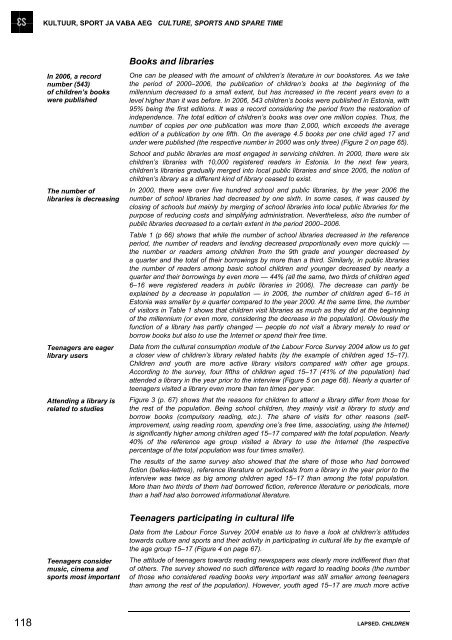LAPSED CHILDREN - Tartu Ãlikool
LAPSED CHILDREN - Tartu Ãlikool
LAPSED CHILDREN - Tartu Ãlikool
- No tags were found...
Create successful ePaper yourself
Turn your PDF publications into a flip-book with our unique Google optimized e-Paper software.
KULTUUR, SPORT JA VABA AEG CULTURE, SPORTS AND SPARE TIME<br />
In 2006, a record<br />
number (543)<br />
of children’s books<br />
were published<br />
The number of<br />
libraries is decreasing<br />
Teenagers are eager<br />
library users<br />
Attending a library is<br />
related to studies<br />
Teenagers consider<br />
music, cinema and<br />
sports most important<br />
Books and libraries<br />
One can be pleased with the amount of children’s literature in our bookstores. As we take<br />
the period of 2000–2006, the publication of children’s books at the beginning of the<br />
millennium decreased to a small extent, but has increased in the recent years even to a<br />
level higher than it was before. In 2006, 543 children’s books were published in Estonia, with<br />
95% being the first editions. It was a record considering the period from the restoration of<br />
independence. The total edition of children’s books was over one million copies. Thus, the<br />
number of copies per one publication was more than 2,000, which exceeds the average<br />
edition of a publication by one fifth. On the average 4.5 books per one child aged 17 and<br />
under were published (the respective number in 2000 was only three) (Figure 2 on page 65).<br />
School and public libraries are most engaged in servicing children. In 2000, there were six<br />
children’s libraries with 10,000 registered readers in Estonia. In the next few years,<br />
children’s libraries gradually merged into local public libraries and since 2005, the notion of<br />
children’s library as a different kind of library ceased to exist.<br />
In 2000, there were over five hundred school and public libraries, by the year 2006 the<br />
number of school libraries had decreased by one sixth. In some cases, it was caused by<br />
closing of schools but mainly by merging of school libraries into local public libraries for the<br />
purpose of reducing costs and simplifying administration. Nevertheless, also the number of<br />
public libraries decreased to a certain extent in the period 2000–2006.<br />
Table 1 (p 66) shows that while the number of school libraries decreased in the reference<br />
period, the number of readers and lending decreased proportionally even more quickly —<br />
the number or readers among children from the 9th grade and younger decreased by<br />
a quarter and the total of their borrowings by more than a third. Similarly, in public libraries<br />
the number of readers among basic school children and younger decreased by nearly a<br />
quarter and their borrowings by even more — 44% (all the same, two thirds of children aged<br />
6–16 were registered readers in public libraries in 2006). The decrease can partly be<br />
explained by a decrease in population — in 2006, the number of children aged 6–16 in<br />
Estonia was smaller by a quarter compared to the year 2000. At the same time, the number<br />
of visitors in Table 1 shows that children visit libraries as much as they did at the beginning<br />
of the millennium (or even more, considering the decrease in the population). Obviously the<br />
function of a library has partly changed — people do not visit a library merely to read or<br />
borrow books but also to use the Internet or spend their free time.<br />
Data from the cultural consumption module of the Labour Force Survey 2004 allow us to get<br />
a closer view of children’s library related habits (by the example of children aged 15–17).<br />
Children and youth are more active library visitors compared with other age groups.<br />
According to the survey, four fifths of children aged 15–17 (41% of the population) had<br />
attended a library in the year prior to the interview (Figure 5 on page 68). Nearly a quarter of<br />
teenagers visited a library even more than ten times per year.<br />
Figure 3 (p. 67) shows that the reasons for children to attend a library differ from those for<br />
the rest of the population. Being school children, they mainly visit a library to study and<br />
borrow books (compulsory reading, etc.). The share of visits for other reasons (selfimprovement,<br />
using reading room, spending one’s free time, associating, using the Internet)<br />
is significantly higher among children aged 15–17 compared with the total population. Nearly<br />
40% of the reference age group visited a library to use the Internet (the respective<br />
percentage of the total population was four times smaller).<br />
The results of the same survey also showed that the share of those who had borrowed<br />
fiction (belles-lettres), reference literature or periodicals from a library in the year prior to the<br />
interview was twice as big among children aged 15–17 than among the total population.<br />
More than two thirds of them had borrowed fiction, reference literature or periodicals, more<br />
than a half had also borrowed informational literature.<br />
Teenagers participating in cultural life<br />
Data from the Labour Force Survey 2004 enable us to have a look at children’s attitudes<br />
towards culture and sports and their activity in participating in cultural life by the example of<br />
the age group 15–17 (Figure 4 on page 67).<br />
The attitude of teenagers towards reading newspapers was clearly more indifferent than that<br />
of others. The survey showed no such difference with regard to reading books (the number<br />
of those who considered reading books very important was still smaller among teenagers<br />
than among the rest of the population). However, youth aged 15–17 are much more active<br />
118<br />
<strong>LAPSED</strong>. <strong>CHILDREN</strong>

















